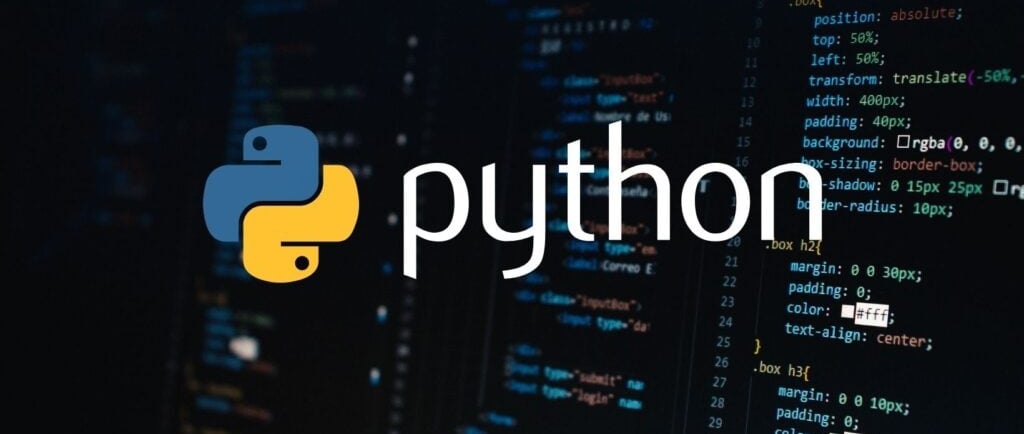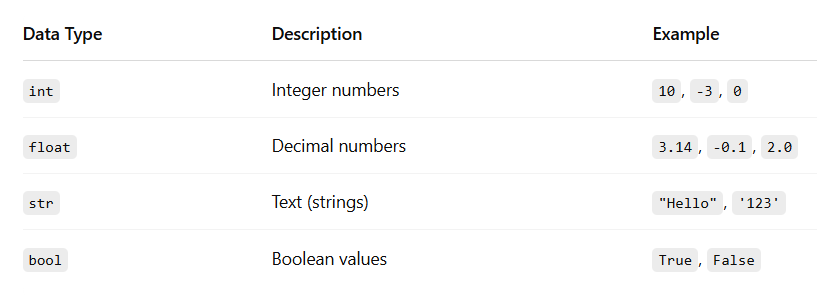Getting Started with Python: Data Types, User Input, and Output Formatting
PYTHON
Kishore Babu Valluri
4/23/20253 min read


Python is one of the most beginner-friendly programming languages out there. Whether you're diving into data science, automation, or web development, understanding the basics is your first step. In this post, we’ll cover some core concepts:
Python Data Types
Taking User Input
Output Formatting
🔢 1. Python Data Types
In Python, every value has a type. Knowing the basic data types helps you store and manipulate different kinds of data effectively.


Example 1: variables
age = 25 # int
height = 5.9 # float
name = "Alice" # str
is_student = True # bool
print(type(age))
print(age)
print(type(height))
print(height)
print(type(name))
print(name)
print(type(is_student))
print(is_student)
Output:
<class 'int'>
25
<class 'float'>
5.9
<class 'str'>
Alice
<class 'bool'>
True
Example 2: Taking user input
Python provides the input() function to accept input from users.
code:
name = input("Enter your name: ")
print("Hello,", name)
#By default, input() returns a string. If you need a number, you’ll need to convert it:
age = int(input("Enter your age: "))
print("Next year you will be", age + 1)
Output:
Enter your name: kishore
Hello, kishore
Enter your age: 40
Next year you will be 41
3. Output Formatting
Neat output makes your program user-friendly. Let’s look at different ways to format output in Python.
✅ 1. Using + to Concatenate
name = "Alice"
print("Hello " + name + "!")
Output:
Hello Alice!
✅ 2. Using , in print()
age = 25
print("You are", age, "years old.") # Automatically adds space and handles different types
Output:
You are 25 years old.
✅ 3. Using f-strings (Best Practice)
name = "Alice"
age = 25
print(f"{name} is {age} years old.")
Output:
Alice is 25 years old.
✅ 4. Formatting Numbers
price = 49.9999
print(f"The price is ${price:.2f}")
Outputs:
The price is $50.00
💡 f-strings are available in Python 3.6 and above. They’re concise and powerful!
💱 Example 1: Currency Conversion
Convert USD to INR (or any currency based on a fixed rate).
# Currency Conversion: USD to INR
usd = float(input("Enter amount in USD: "))
conversion_rate = 83.25 # 1 USD = 83.25 INR (example rate)
inr = usd * conversion_rate
print(f"${usd:.2f} is equivalent to ₹{inr:.2f}")
Output:
Enter amount in USD: 3 $3.00 is equivalent to ₹249.75
💰 Example 2: Monthly Salary Calculation
Calculate total monthly salary with basic pay, HRA, and allowances.
# Monthly Salary Calculator
basic_pay = float(input("Enter basic pay: "))
hra = float(input("Enter HRA: "))
allowances = float(input("Enter other allowances: "))
total_salary = basic_pay + hra + allowances
print(f"Total Monthly Salary: ₹{total_salary:.2f}")
Output:
Enter basic pay: 10000
Enter HRA: 10
Enter other allowances: 2000
Total Monthly Salary: ₹12010.00
🛒 Example 3: Simple Bill Calculator
Calculate the total cost of items with quantity and unit price.
# Simple Bill Calculator
item_name = input("Enter item name: ")
price = float(input("Enter price per item: "))
quantity = int(input("Enter quantity: "))
total = price * quantity
print(f"{quantity} x {item_name} @ ₹{price:.2f} each = ₹{total:.2f}")
Output:
Enter item name: computer
Enter price per item: 70000
Enter quantity: 2
2 x computer @ ₹70000.00 each = ₹140000.00
🧮 Example 4: Simple Interest Calculator
Calculate interest for a fixed deposit.
# Simple Interest Calculator
principal = float(input("Enter principal amount: "))
rate = float(input("Enter annual interest rate (in %): "))
time = float(input("Enter time in years: "))
simple_interest = (principal * rate * time) / 100
print(f"Simple Interest = ₹{simple_interest:.2f}")
Output:
Enter principal amount: 50000
Enter annual interest rate (in %): 10
Enter time in years: 2
Simple Interest = ₹10000.00
🎓 Example 5: Student Grade Summary
Accept marks and print average with formatted output.
# Student Grade Summary
name = input("Enter student name: ")
math = float(input("Enter marks in Math: "))
science = float(input("Enter marks in Science: "))
english = float(input("Enter marks in English: "))
average = (math + science + english) / 3
print(f"{name}'s Average Score: {average:.2f}")
Output:
Enter student name: kishore
Enter marks in Math: 90
Enter marks in Science: 95
Enter marks in English: 85
kishore's Average Score: 90.00
🚀 Quick Tips Recap:
Use float() for decimal inputs.
Use int() when you need whole numbers.
Format outputs using f-strings: f"{value:.2f}" for 2 decimal places.
Build logic step-by-step from user input to output.


Kishore Babu Valluri
Senior Data Scientist | Freelance Consultant | AI/ML & GenAI Expert
With deep expertise in machine learning, artificial intelligence, and Generative AI, I work as a Senior Data Scientist, freelance consultant, and AI agent developer. I help businesses unlock value through intelligent automation, predictive modeling, and cutting-edge AI solutions.
Let's Get in Touch
marketing@deepaiautomation.com
+91 6309397994
© 2025. All rights reserved.
Industries
Manufacturing
Financial Services
Retail
Solutions
DocuMind AI - Intelligent Document Migration
InsightEdge AI - Intelligent Power BI Reporting & Analytics
DCT AI - Digital Control Tower for Intelligent Enterprise Visibility
Inventra AI - Intelligent Inventory Optimization Platform
Maintenix AI - Predictive Maintenance Intelligence Platform
PayPredict AI - Intelligent Customer Payment Prediction Platform
SegMind AI - Intelligent Customer Segmentation & RFM Analytics Platform
DataForge AI - Intelligent ETL & Analytics Modernization Platform
DataSense AI - Intelligent Data Quality & Outlier Detection Agent
